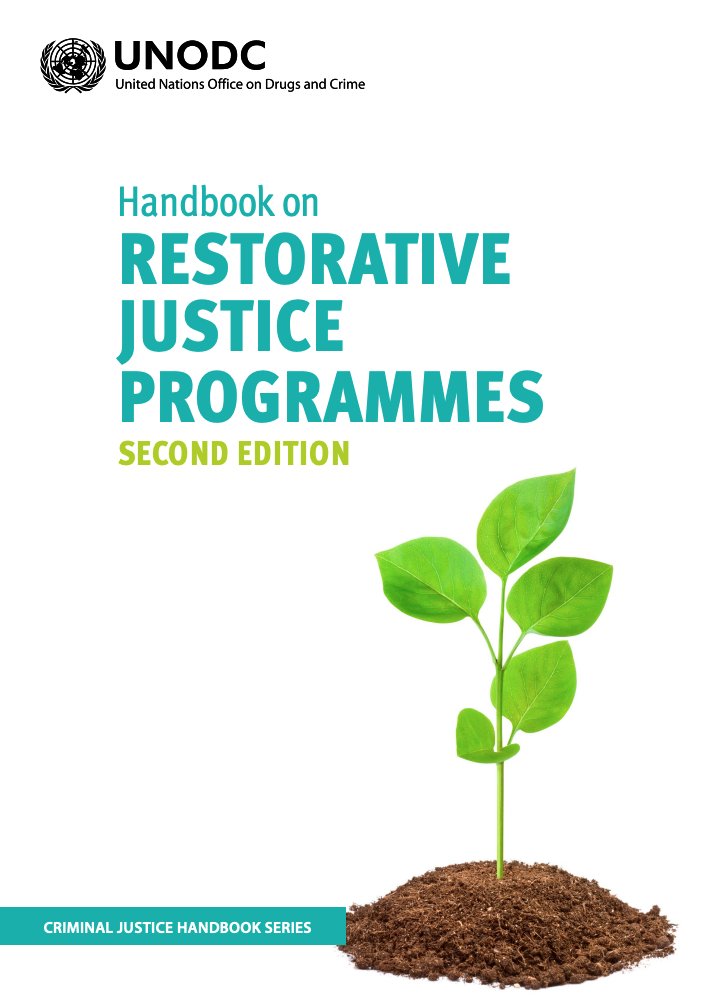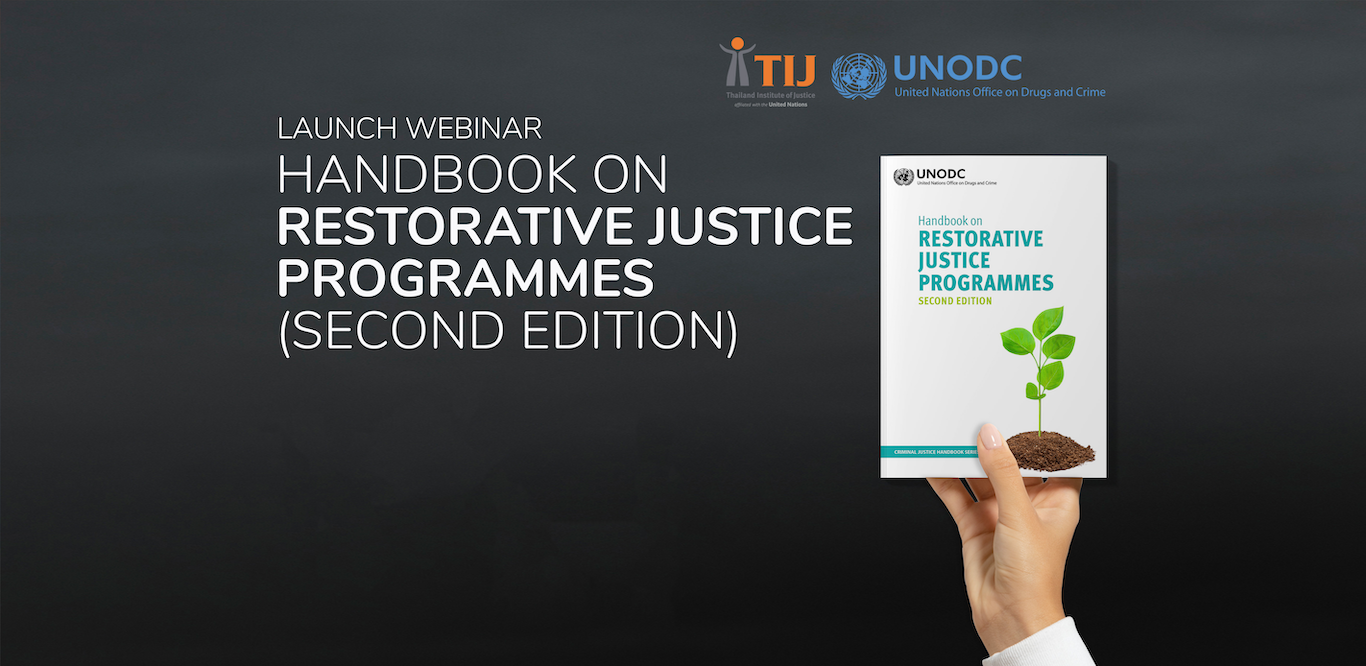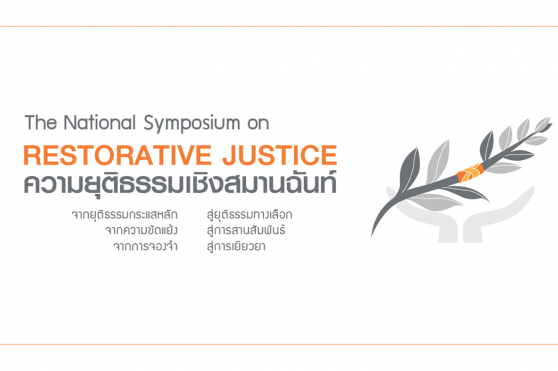Webinar Summary: Launch Webinar of the Handbook on Restorative Justice Programmes (Second Edition)
Executive Summary
This report summarizes the guidelines and recommendations provided by experts on restorative justice who were speakers at the Launch Webinar of the Handbook on Restorative Justice Programmes (Second Edition). This Handbook, developed by the United Nations Office on Drugs and Crime (UNODC) in collaboration with the Thailand Institute of Justice (TIJ), was updated to be more current and diverse, making the handbook suitable for various actors in the criminal justice system - policymakers, legislators, criminal justice practitioners, members of civil society, and entities active in the field of criminal justice reform - both as a reference document and a training tool. During the webinar, each speaker emphasized the importance of strategic communication to create understanding and faith in restorative justice among the public. The speakers also emphasized the significance of multi-stakeholder collaboration such as collaboration between the Ministry of Justice, law enforcement, communities, victims and offenders. The webinar further highlighted the flexible definition of restorative justice which is in accordance with principles, values, community history, culture and actual needs of the victim.
The recommendations from the webinar are as follows:
1. Governments and justice agencies must transform the traditional justice system to pave way for restorative justice to materialize on a structural level. This requires laws and policies that encourage the implementation of restorative justice.
2. Justice organizations and experts must alleviate resistance from the public which results from a lack of understanding, by disseminating information and working together with communities to build trust in restorative justice.
3. Governments and justice agencies must build strong and efficient multi-stakeholder collaboration.
4. The implementation of restorative justice must be in accordance with the social and cultural contexts of each community.
Introduction
Prison overcrowding is one of the most severe issues that the Thai justice system is facing and must seek a solution to, ones of the most concerning issues due to the overcrowding are the wellbeing and prisoners’ access to effective healthcare. The COVID-19 pandemic in Thailand and all around the world reverberates the concerns and emphasizes the need for a justice system that is not dependent on detention and imprisonment. Restorative justice plays its essential part in tackling the stated issues since it can reduce the number of cases that have to be decided in a courtroom and can curtail and prevent imprisonment. Restorative justice provides solutions to the chronic and exacerbating issues such as prison overcrowding.
Restorative justice can be viewed as a component of the rule of law and as a means of widening access to justice. Restorative justice encourages collaboration between the victim and the perpetrator in rehabilitating the harm caused. What follows is a victim-centered approach and the reintegration of the perpetrator back into society as an individual who is responsible for the harm they have caused.
 Since the Handbook on Restorative Justice Programmes was first published in 2006, knowledge and practices surrounding restorative justice, whether as complementary to the traditional justice system or as an alternative, have greatly expanded. This led to the inevitable need to review the Handbook. The Second Edition of the Handbook on Restorative Justice Programmes is a result of the collaborative efforts of experts who collected principles and ideas about restorative justice, including examples o how to design, monitor and evaluate restorative justice programmes. Nevertheless, the key to the success of restorative justice is the collaboration between every sector; consequently, the Thailand Institute of Justice supports the transformation of justice that encompasses everyone by co-publishing the Handbook on Restorative Justice Programme and hosting this launch webinar.
Since the Handbook on Restorative Justice Programmes was first published in 2006, knowledge and practices surrounding restorative justice, whether as complementary to the traditional justice system or as an alternative, have greatly expanded. This led to the inevitable need to review the Handbook. The Second Edition of the Handbook on Restorative Justice Programmes is a result of the collaborative efforts of experts who collected principles and ideas about restorative justice, including examples o how to design, monitor and evaluate restorative justice programmes. Nevertheless, the key to the success of restorative justice is the collaboration between every sector; consequently, the Thailand Institute of Justice supports the transformation of justice that encompasses everyone by co-publishing the Handbook on Restorative Justice Programme and hosting this launch webinar.
Summary of the Launch Webminar
Opening Remarks By Prof. Dr. Kittipong Kittayarak
Executive Director of the Thailand Institute of Justice
Over a decade ago in 2006, the First Edition of the Handbook on Restorative Justice Programmes was published by the UNODC. Since then, restorative justice, or “harmonious justice,” as more commonly known in Thailand, has become increasingly recognized as an important measure to enhance the rule of law and access to justice. Restorative justice is a rights-based approach as it puts the victims at the heart of the criminal justice system while reinforcing the link between the rule of law and sustainable development. In light of the COVID-19 pandemic, the dangers of prison overcrowding are clear and present. If this has already triggered a policy rethink in many countries towards non-custodial measures, for example, I feel that restorative justice, too, should be further promoted more widely. And for this reason, I think the launch of this Handbook cannot be timelier.
The Handbook covers a wide range of topics including good practices for programme design and implementation, the mobilization of community assets, as well as programme monitoring and evaluation techniques. To support countries in advancing restorative practices, this Handbook also presents information and examples that will be useful in the development of new programmes in a variety of social, cultural and legal contexts. Against the backdrop of the new normal, I encourage us to think about how restorative justice can contribute to the SDGs and how innovation plays a role in this regard. After all, restorative justice breeds social harmony and community resilience. And we should all take necessary steps to realize that common vision of ours.
Introduction of the Handbook
Speaker: Ms. Jee Aei Lee
Crime Prevention and Criminal Justice Officer, Justice Section, UNODC
The Handbook on Restorative Justice Programmes (Second Edition) is an offspring of the Handbook on Restorative Justice Programmes first published in 2006 by the United Nations Office on Drugs and Crime to disseminate ideas and principles that were foundational to restorative justice and also processes and guidance to promote restorative practices. The first handbook was a product of the resolution made by the United Nations Economic and Social Council in 2002 which demanded that countries that had restorative justice process implement it as part of the justice system.
Since then, restorative justice principles and practices have greatly expanded. Many countries around the world have begun introducing restorative practices or at the very least, expressing their interest in restorative justice. Such initatives led to a conference among restorative justice experts in 2017 in Ottawa, Canada, to discuss the future of restorative justice. In 2019, there was a conference between experts in restorative justice and representatives of the Thai government to exchange information and knowledge about the current state of restorative justice. The conference highlighted the need to develop a more comprehensive and updated Handbook with additional examples from various countries. As a result, it was decided that the Handbook on Restorative Justice Programmes would be revised and updated to include information necessary for the advancement of restorative justice programmes.
In this latest edition, the emphasis is placed on the principles of restorative justice under the current social context, with a broadened definition and framework of the concept. For instance, how to respond to serious crimes (such as intimate partner violence), observations and limitations that need to be considered before bringing the victim and the perpetrator into the restorative justice process, and how to approach the victim in such a way they feel that the justice system is safe and meaningful. Other subject matters that have been added into the new edition include programme oversight, monitoring and evaluation, guidelines and recommendations for implementation, and the role of the community as a mediator to name a few. Throughout the Handbook, there are up-to-date studies and examples of applications of restorative justice from several countries around the world; thus the Handbook can be used to develop training tools for practitioners in the criminal justice system as well as a reference document for legislative and policy reform.
Enabling the national roadmap for restorative justice
Speaker: Yvon Dandurand
Fellow and Senior Associate at the International Centre for Criminal Law Reform and Criminal Justice Policy
Since the resolution by the United Nations Economic and Social Council which led to definitions for restorative justice, only a few countries have been successful in incorporating restorative justice as part of the national roadmap. It can be said that while restorative justice is accepted on an international scale, it has not sufficiently penetrated traditional criminal justice systems on a national level.
Although attempts to implement restorative justice have led to policies that respond to the non-traditional justice, most people still lack the understanding that there are more approaches rather than one to incorporate restorative justice into the traditional justice system. Each country can have their own way to evaluate and adapt restorative justice depending on their social and cultural context. Thus, each country should develop its own roadmap for restorative justice with the consideration of cultural differences and open up the opportunity for citizens to participate in the development or else the attempts that come only from experts and authorities on the ivory tower may not yield fruitful results.
In the past decade, some countries have their own frameworks in monitoring and evaluating restorative justice programmes. Knowledge from such assessment has bridged the gap between the authorities and citizens who need help from the justice system. Restorative justice has helped victims to feel that they have been rehabilitated. However, the initiation of restorative justice has been going on under several limitations since the laws and policies that respond to the non-traditional justice have not been formulated or enforced. Apart from that, there are challenges in working to support restorative justice which are victims’ inaccessibility to the justice system, the lack of support from the authorities in the justice system, resistance from the public and the failure to invite people from every sector to participate in restorative justice process, for instance, families from both the victim and the perpetrator and the community’s leaders who might be harmed as well. Transcending obstacles and challenges thus depend on multi-stakeholder collaboration, both from inside and outside the justice system, and continual effort.
Challenges and lessons learned in restorative justice
Speaker: Marilou Reeves
Counsel, Criminal Law Policy Section, Department of Justice Canada
One consensus reached at the 2019 Expert Group Meeting on Restorative Justice in Bangkok was that restorative justice is the manifestation of the failure of the traditional criminal justice system, which revictimizes the injured party instead of rehabilitating them. Thus, what has emerged in countries across the world is a different way of conducting restorative processes based on principles that aim to repair harm rather than impose further harm.
A lesson learned about restorative justice comes from Canada - a large country with a diverse population. Canada manifests the necessity of collaboration. The country has a territorial working group that has been working on restorative justice since 1997. The administration of justice in Canada is a provincial responsibility; thus, people have had to work together across different regions to achieve restorative justice in every territory and province until Canada adopted the principles of restorative justice.
Furthermore, the legacy of colonialism in Canada leads to many indigenous people ending up in the criminal justice system; as a result, restorative justice in Canada recognizes the colonial legacy and listens to the indigenous people. In the past 25 years, Canada has adopted an indigenous community-led restorative justice programme which operates in accordance with the experiences, values, and traditions of the indigenous community. The flexibility of restorative processes is, thus, a hallmark of restorative justice.
Restorative justice does not have a rigid definition, nor is it unbending. It can be serve as complementary to or as an alternative to the traditional criminal justice system, or it can also operate completely separate from the criminal justice system as a means of strengthening justice at the grassroots level.
Restorative justice in practice: Enablers and barriers to sustainable implementation
Speaker: Tim Chapman
Chair of the Board, European Forum for Restorative Justice
This Handbook is like a seed - in a small space it packs lots of knowledge and possibilities, but for it to grow, the knowledge and experiences in the book need to be used and adapted. The Handbook is compulsory for governments and policymakers who want to introduce restorative justice, to understand the meanings and practices that can be developed into policies, and to recognize the relevant stakeholders in restorative justice processes such as civil society organizations and community members.
Restorative justice is less costly in the long run - it creates an environment where victims can heal in a shorter amount of time and may also alleviate prison overcrowding. Because of this, support from every sector including judges, lawyers, public prosecutors, police and civil society, and the public, is necessary. The pathway to achieving cross-sectoral collaboration is to raise public awareness and ehance the knowledge and understanding of restorative practices.
Governments and policymakers should concentrate on building efficient restorative justice programmes. High quality training by experienced trainers combined with the support of supervisors who understand the nature and benefits of restorative justice is essential. At present, literature on restorative justice comes mostly from the Western countries - it would be interesting to see restorative justice research from elsewhere too. Social and cultural differences from other countries will produce a more comprehensive understanding and will help pave the way for the advancement of restorative justice. In this regard, countries are encouraged to engage in independent research in order to develop their own national model of restorative justice - one that will operate effectively at the local level.
Q&A Session
Question: Did I understand correctly that according to the study that has been recently conducted, many countries have declared that restorative justice as the new crime response still remains underused because of insufficient institutionalisation and implementation in the legislation?
Yvon Dandurand: I think this is what I was trying to convey to a certain degree. In many countries, policies, laws, and authorities encourage the implementation of restorative justice. But in most instances, the aspiration is much greater than reality. But now countries everywhere can benefit from the recommendations provided in the Handbook.
Question: Should we use restorative justice for victimless crime and how we could set up the meeting for these crimes?
Tim Chaman: When devising the schemes of restorative justice, we need to be careful about how we identify victims. There are obviously direct victims, for instance, when somebody steals something from someone else. But most crimes, if not all crimes, cause harm and that is the key concept of restorative justice, which is how do you repair the harm? Usually, with a little bit of imagination, you can identify the people that have been harmed by the crime, even when they have not had a direct relationship with that crime. We have some experience, for instance, with crimes against corporate property and drug crimes that usually. In such situations, we can question the ‘ripple effect’ of the harm and who has been affected. Sometimes the perpetrator’s family is harmed and restorative justice has a family group conference approach for this. We also have had other situations such as crime against community and we bring in representatives of that community, which goes back to the indigenous form of justice where there is a community circle of people who not only wants to express their disapproval of the crime, but also to offer support to the person in changing their behaviour. We should be creative and imaginative with how we apply restorative justice to local circumstances.
Question: Can restorative justice be equated to Alternative Dispute Resolution (ADR) in some jurisdiction?
Marilou: Alternative dispute resolution is a field that has been in existence for a decade and certainly in a civil case context or in a family law context. To a degree, the model of meeting has been translated into a restorative process. There is a lot to be learned from the alternative dispute resolution processes but the value-added with the restorative process is that it is grounded in principles that are broader and more holistic than just looking at a single dispute between parties. Traditionally, restorative justice talks about the harm being done to the person who caused the harm, the victim and community, and overall, it is a more holistic attempt at redressing the harm caused.
Question: What can the UN bodies and institutions and the UN-affiliated regional organizations like United Nations Latin American Institute for the Prevention of Crime and the Treatment of Offenders (ILANUD) in Latin America do to support effective implementation of restorative justice, in particular in the Southern Hemisphere and come with common vision and strategy?
Jee Aei Lee: UN-affiliated bodies including other agencies and United Nations Crime Prevention and Criminal Justice Programme Network (PNI) and other CSOs that have been active in the field of restorative justice play an enormously influential and crucial role in promoting it. In addition to being a technical assistance provider, they also serve as a great source of a wide range of expertise in all areas, in mobilizing the entire justice system to realize and incorporate the values of restorative justice in their implementation of programmes, in providing legislative and policy advice, and in training, monitoring and evaluating restorative approaches. I would like to invite affiliated bodies and CSOs to reach out to us, to foster and engage in more partnership in areas that we can collaborate, especially on a regional level because we cannot do it alone.




